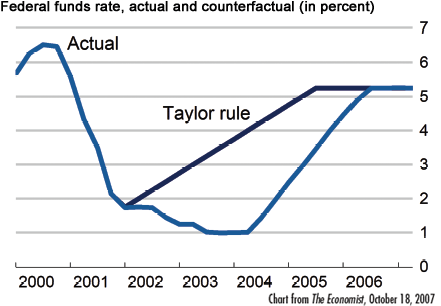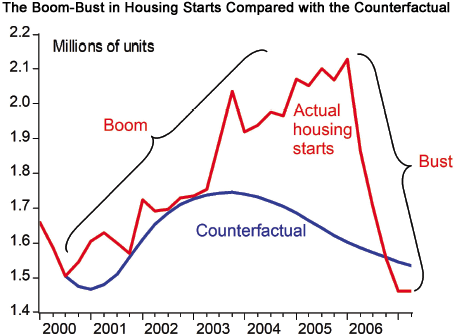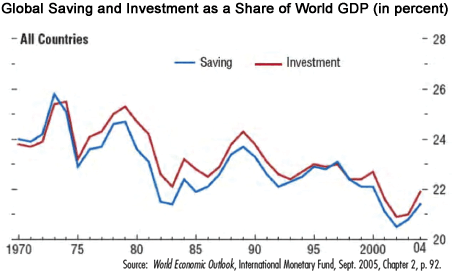
OVERVIEW
MANAGEMENT
PERFORMANCE
POSSIBILITIES
CAPITALS
ACTIVITIES
ACTORS
BURGESS
People ... Economists |
|
COMMENTARY Over the next couple of years, the stock market did not decline, it went higher and higher and higher as the dot.com bubble developed. In due course, of course, the bubble burst, but the damage was not devastating for one simple reason ... a huge amount of money had been invested in failed businesses that had invested heavily in R&D and in building a huge amount of infrastructure. Though the profits never materialized, these investments remained for the future. As the dot,com bubble subsided, the financial markets, in their infinite wisdom, and with the support of the economic genius Greenspan at the Federal Reserve, a new bubble was born. This time it was in real estate. Super low interest rates makes it quite low cost to finance real estate ... and banks make money profit simply by processing financial instruments ... what happens to these financial instruments in the future is of no concern to the 'transactors' though it will matter immensely to the holders of these 'when the music stops'!
So here we are ... about 15 years later, and the market is just about where I though it ought to be in 1997 adjusted for some modest inflation. I used to have some respect or reference for the 'high priests' of economics, politics, business, academia and so on ... but it seems that many of those in the public eye are like the 'Emperor with no clothes' and now seem to have been serially wrong, and society is having to pay a very high price.
|
|
It Really Is All Greenspan's Fault ... Not wrong once, but wrong over and over again! Ask John Taylor ... It's been quite a spectacle for those who have followed Alan Greenspan's career for decades. Gone is the financial rock star or even the statesman testifying before Congress in a measured baritone. Instead, over the past several months, Alan Greenspan has morphed into a totally new person. The first incarnation was the shaken Greenspan who was stunned that greedy and reckless short-term behavior could overwhelm long-term, rational self-interest. That was rather amazing all by itself. But now, there's a newer Greenspan--a decidedly prickly and whiny one. I'm talking about Greenspan's recent op-ed in The Wall Street Journal. A 1,500-word attempt to move blame for the financial crisis away from himself and onto ... China. It was, writes Greenspan, Chinese growth that led to 'an excess' of global savings. That growth kept long-term interest rates low, which fueled the housing bubble. As for himself, the lowly chairperson of the Fed, he says he was helpless. He only had control over short-term rates. Why this recent incarnation as a self-pitying victim of historical forces? Most likely, it's because of John Taylor, a mild-mannered professor at Stanford and former colleague of Greenspan's at the Fed. In his Getting Off Track, a nifty little book, Taylor exposes, as plain as day, the culprit behind the financial boom-bust: Greenspan. His weapon of choice is the 'Taylor rule' (discovered by Taylor--but not named by him, as he modestly points out.) (The Taylor rule is a recommendation about how the Fed should set the short interest rate--suggesting the amount it should be changed given economic conditions.) Here's Taylor's take. Short interest rates fell in 2001 in response to the dot-com bust. But--and here's the important moment--beginning in 2002, the Taylor rule indicated that Greenspan ought to have tightened. Indeed, from 2002 to 2005, rates ought to have climbed to a touch over 5% and then stayed there through 2006. But the Fed kept to a loose monetary stance, and rates kept falling during the period 2002 through 2004. Rates didn't start back up until middle of 2004 and didn't reach 5% until 2006. You can check this out in Figure 1, below.
The result? The Greenspan Loose policy went on to fuel a boom, while the Taylor Tight would have avoided one. As Taylor says, all the Fed needed to do was follow '... the kind of policy that had worked well during the period of economic stability called the Great Moderation, which began in the early 1980s.' The connection between Greenspan Loose and the housing boom is also clear. Housing starts took a sharp spike up in 2003 and then continued to climb through 2006. If the Fed had followed Taylor Tight, however, housing starts would have peaked at a much lower level at the end of 2003, and drifted down through 2006.
What about Greenspan's argument that he only controlled short-term rates? And that short rates became decoupled from long-term rates in 2002? Nonsense, says Taylor. Surely the existence of adjustable-rate mortgages (accounting for about one-third of mortgages starting in 2003) linked the mortgage market and short-term rates. Moreover, says Taylor, whatever minor decoupling occurred, happened because bond investors were flummoxed by the Fed's odd behavior. Taylor also takes on Greenspan's excuse that he was helpless in the face of a global saving glut. Cutting off the feet of Greenspan's excuse, Taylor says there wasn't a glut, there was a shortage. Figures from the International Monetary Fund show global saving rates, as a share of world GDP, were low during 2002 to 2004--way lower than rates in the 1970s and 1980s. In fact, the global saving rate fell at the end of 1990s, hitting bottom about 2003.
Greenspan's monetary excess was also crucial in setting off a chain of bad government policies. As Taylor argues, Greenspan Loose was amplified by the popularity of subprime mortgages, especially adjustable-rates, which promoted risk taking. And it made for a lethal brew in a pot of policies to promote homeownership. Greenspan pulls out many stops in his defense. He even quotes the great Milton Friedman's approving assessment of Fed policy between 1987 and 2005. Well, Friedman died in 2006 and, in 2009, his equally great colleague, Anna Schwartz, has this to say: 'There never would have been a subprime mortgage crisis if the Fed had been alert. This is something Alan Greenspan must answer for.' As for Greenspan's argument that the whole mess is China's fault, she says tartly: 'This attempt to exculpate himself is not convincing. The Fed failed to confront something that was evident. It can't be blamed on global events.' As fine a last word as there could be. Susan Lee has written several books on economics, including a college text. She is an economics commentator for NPR's 'Marketplace' and writes a weekly column for Forbes. |
|
Susan Lee writing in Forbes
04.03.09, 12:01 AM EDT |
| The text being discussed is available at http://www.forbes.com/2009/04/02/greenspan-john-taylor-fed-rates-china-opinions-columnists-housing-bubble.html |


